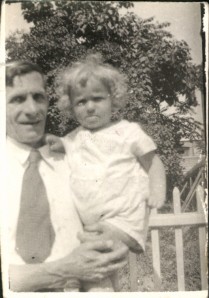One hundred years ago today, my great grandfather, Aaron Naginsky, arrived in America.
I’ve described his trip from Russia to New York’s Ellis Island in an earlier post. I’ve also shared what I learned about his childhood and adulthood. But given this significant milestone, I wanted to dedicate this post to “papa” and include everything I’ve been able to gather about him in one place.
Aaron was born in about 1879 in Pohar, Russia, the second child of Ann Voloff and Morris Naginsky, a cantor. His older brother, Israel, was about 2 years old when he was born; he was about 6 when his sister Mary arrived and 13 when the youngest, Sadie, came along. He would marry at about age 26, and he was about 28 when his first child was born; the following year, the family would move to Aleksandrovsk, Russia, where his four other daughters would be born during the next six years. He was about 35 years old when he left for America in 1914. He became a naturalized U.S. citizen on July 14, 1921.
Aaron would make a living as a butcher in Russia and later in America, but he spent most of his working years in New York as a capmaker in the Garment District. Presumably, his first job was at Supreme Caps Co., located at 51 West Third Street, where his brother was working as of 1918. Sometime during the 1920s, we were told the family lived in Linden, New Jersey, and operated a butcher shop there; however, I have yet to find any official documentation of this. As of 1930, he and the family were back in Brooklyn, according to the census, which recorded his profession as a capmaker again. His last job was at Buchbinder & Co., located at 43 West 46th Street, where his sister Sadie’s husband, Sam Silvert, was a partner.
Aaron may have had a typical working-class immigrant experience, characterized by long hours and hard work, but the sweat shop role did not define him. As I’ve noted in previous posts, family members say he was interested in politics and loved music, especially Russian composers. They also describe him as a quiet, gentle man.
Throughout his adulthood, he struggled with his health. He contracted tuberculosis while still in Russia, and, according to family accounts, he was treated for the disease in America as well, spending a year at the New Jersey Sanitarium — something I have yet to document. His daughter Ada always remembers him “coughing his head off” and having asthma. His granddaughter Judith Bradfield Tomero remembers him injecting himself with insulin because of diabetes.
Despite the challenges he faced in his life, when he died of heart disease on Dec. 23, 1945, at age 66, I like to think he was content. In addition to his five daughters and sons-in-law, there was now a new generation of American-born Naginsky descendants: three granddaughters and seven grandsons. The youngest, 3-year-old twins Nick and Bob, would visit him when he was ill and bed-ridden, but Nick would “retain an image in my mind of him cheering up at our visit.” Seeing them, I expect, was the fulfillment of a dream.

However mundane the subject, you manage to make it seem momentous and quite wonderful. I’m always moved by your narrative.
My maternal grandmother, Nagin(sky) family came from Poltava (now Ukraine). Do you know Morris Naginsky’s father’s name? Do you have DNA data for the Naginsky family. I would be interested to see if we are related!
You have created a wonderful website to hold your stories and images. I too am working on the same for both sides of my family.
Hi Rachel — thanks for the comment! Unfortunately, I don’t have any information on my great great great grandparents (2x GGP?). Morris and Anne Woloff are as far back in my family tree that I’ve been able to go. I also haven’t done a DNA test since I felt like I knew most of what I needed to know about my family origin, but I’d be open to it, especially if I thought it could help me uncover more people in my tree.